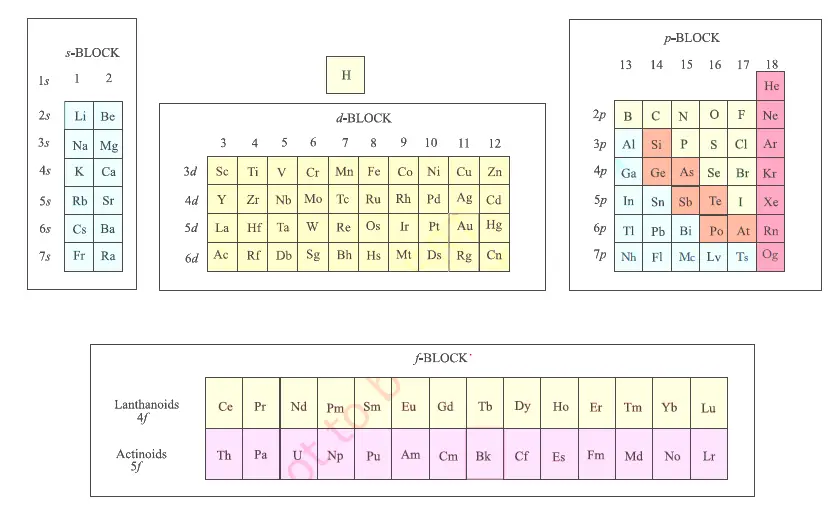


|
Period |
Highest principle quantum number(n) or Principal Valence Shell |
Total electrons possible |
Number of elements |
|
1 |
1 |
2(1s) |
1 |
|
2 |
2 |
8(2s, 2p) |
8 |
|
3 |
3 |
8(3s, 3p) |
8 |
|
4 |
4 |
18(4s,3d,4p) |
18 |
|
5 |
5 |
18(5s,4d,5p) |
18 |
|
6 |
6 |
32(6s,4f,5d,6p) |
32 |
|
7 |
7 |
32(7s,5f,6d,7p) |
32(incomplete) |
|
Digit |
Name |
Abbreviation |
|
0 |
Nil |
n |
|
1 |
Un |
u |
|
2 |
Bi |
b |
|
3 |
Tri |
t |
|
4 |
Quad |
q |
|
5 |
Pent |
P |
|
6 |
Hex |
h |
|
7 |
Sept |
s |
|
8 |
Oct |
o |
|
9 |
Enn |
e |


|
Elements |
Symbol |
Atomic Number |
|
Actinium |
Ac |
89 |
|
Aluminum |
Al |
13 |
|
Americium |
Am |
95 |
|
Antimony |
Sb |
51 |
|
Argon |
Ar |
18 |
|
Arsenic |
As |
33 |
|
Astatine |
At |
85 |
|
Barium |
Ba |
56 |
|
Berkelium |
Bk |
97 |
|
Beryllium |
Be |
4 |
|
Bismuth |
Bi |
83 |
|
Bohrium |
Bh |
107 |
|
Boron |
B |
5 |
|
Bromine |
Br |
35 |
|
Cadmium |
Cd |
48 |
|
Calcium |
Ca |
20 |
|
Californium |
Cf |
98 |
|
Carbon |
C |
6 |
|
Cerium |
Ce |
58 |
|
Cesium |
Cs |
55 |
|
Chlorine |
Cl |
17 |
|
Chromium |
Cr |
24 |
|
Cobalt |
Co |
27 |
|
Copernicium |
Cn |
112 |
|
Copper |
Cu |
29 |
|
Curium |
Cm |
96 |
|
Darmstadtium |
Ds |
110 |
|
Dubnium |
Db |
105 |
|
Dysprosium |
Dy |
66 |
|
Einsteinium |
Es |
99 |
|
Erbium |
Er |
68 |
|
Europium |
Eu |
63 |
|
Fermium |
Fm |
100 |
|
Flerovium |
Fl |
114 |
|
Fluorine |
F |
9 |
|
Francium |
Fr |
87 |
|
Gadolinium |
Gd |
64 |
|
Gallium |
Ga |
31 |
|
Germanium |
Ge |
32 |
|
Gold |
Au |
79 |
|
Hafnium |
Hf |
72 |
|
Hassium |
Hs |
108 |
|
Helium |
He |
2 |
|
Holmium |
Ho |
67 |
|
Hydrogen |
H |
1 |
|
Indium |
In |
49 |
|
Iodine |
I |
53 |
|
Iridium |
Ir |
77 |
|
Iron |
Fe |
26 |
|
Krypton |
Kr |
36 |
|
Lanthanum |
La |
57 |
|
Lawrencium |
Lr |
103 |
|
Lead |
Pb |
82 |
|
Lithium |
Li |
3 |
|
Livermorium |
Lv |
116 |
|
Lutetium |
Lu |
71 |
|
Magnesium |
Mg |
12 |
|
Manganese |
Mn |
25 |
|
Meitnerium |
Mt |
109 |
|
Mendelevium |
Md |
101 |
|
Mercury |
Hg |
80 |
|
Molybdenum |
Mo |
42 |
|
Moscovium |
Mc |
115 |
|
Neodymium |
Nd |
60 |
|
Neon |
Ne |
10 |
|
Neptunium |
Np |
93 |
|
Nickel |
Ni |
28 |
|
Nihonium |
Nh |
113 |
|
Niobium |
Nb |
41 |
|
Nitrogen |
N |
7 |
|
Nobelium |
No |
102 |
|
Oganesson |
Og |
118 |
|
Osmium |
Os |
76 |
|
Oxygen |
O |
8 |
|
Palladium |
Pd |
46 |
|
Phosphorus |
P |
15 |
|
Platinum |
Pt |
78 |
|
Plutonium |
Pu |
94 |
|
Polonium |
Po |
84 |
|
Potassium |
K |
19 |
|
Praseodymium |
Pr |
59 |
|
Promethium |
Pm |
61 |
|
Protactinium |
Pa |
91 |
|
Radium |
Ra |
88 |
|
Radon |
Rn |
86 |
|
Rhenium |
Re |
75 |
|
Rhodium |
Rh |
45 |
|
Roentgenium |
Rg |
111 |
|
Rubidium |
Rb |
37 |
|
Ruthenium |
Ru |
44 |
|
Rutherfordium |
Rf |
104 |
|
Samarium |
Sm |
62 |
|
Scandium |
Sc |
21 |
|
Seaborgium |
Sg |
106 |
|
Selenium |
Se |
34 |
|
Silicon |
Si |
14 |
|
Silver |
Ag |
47 |
|
Sodium |
Na |
11 |
|
Strontium |
Sr |
38 |
|
Sulfur |
S |
16 |
|
Tantalum |
Ta |
73 |
|
Technetium |
Tc |
43 |
|
Tellurium |
Te |
52 |
|
Tennessine |
Ts |
117 |
|
Terbium |
Tb |
65 |
|
Thallium |
Tl |
81 |
|
Thorium |
Th |
90 |
|
Thulium |
Tm |
69 |
|
Tin |
Sn |
50 |
|
Titanium |
Ti |
22 |
|
Tungsten |
W |
74 |
|
Uranium |
U |
92 |
|
Vanadium |
V |
23 |
|
Xenon |
Xe |
54 |
|
Ytterbium |
Yb |
70 |
|
Yttrium |
Y |
39 |
|
Zinc |
Zn |
30 |
|
Zirconium |
Zr |
40 |